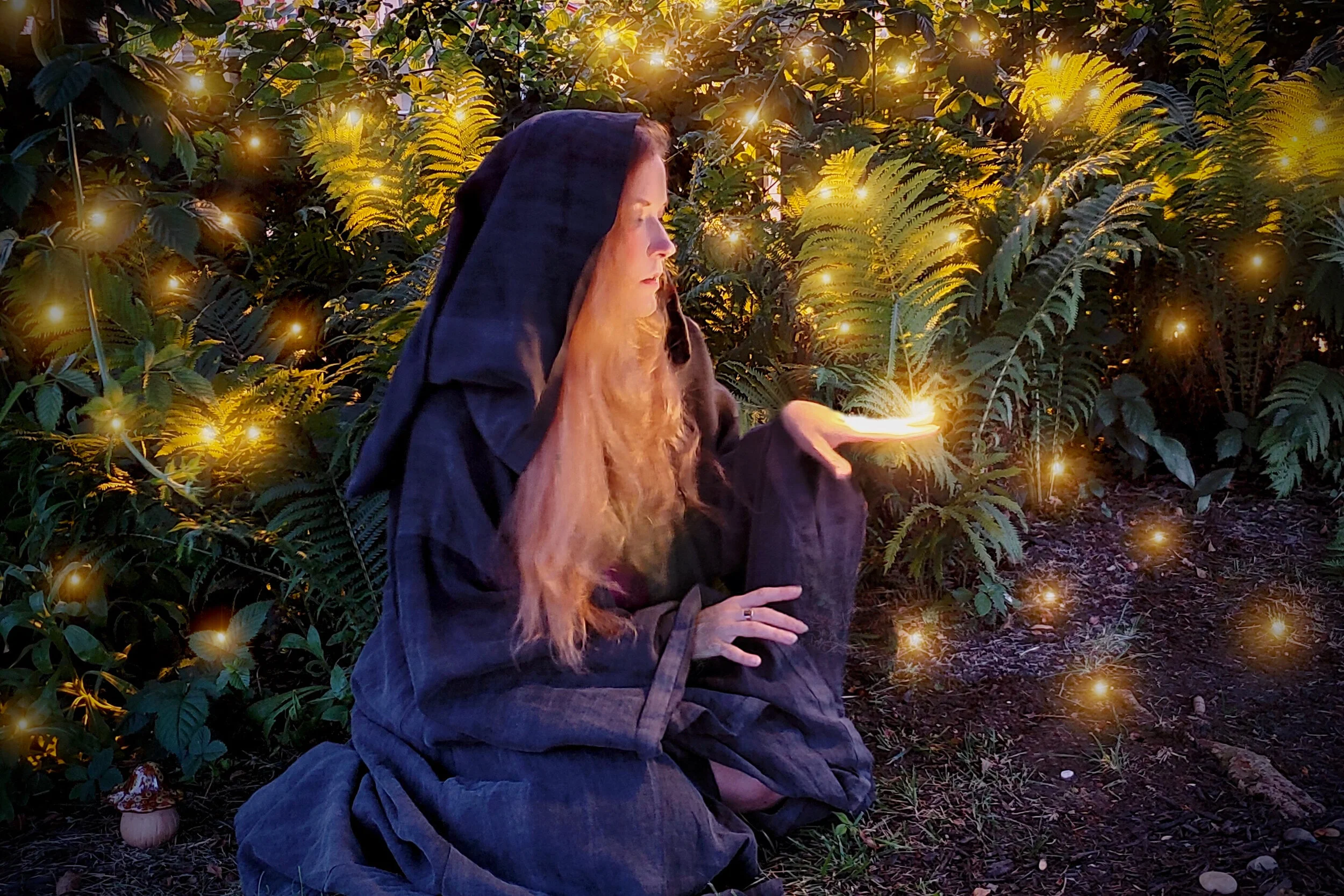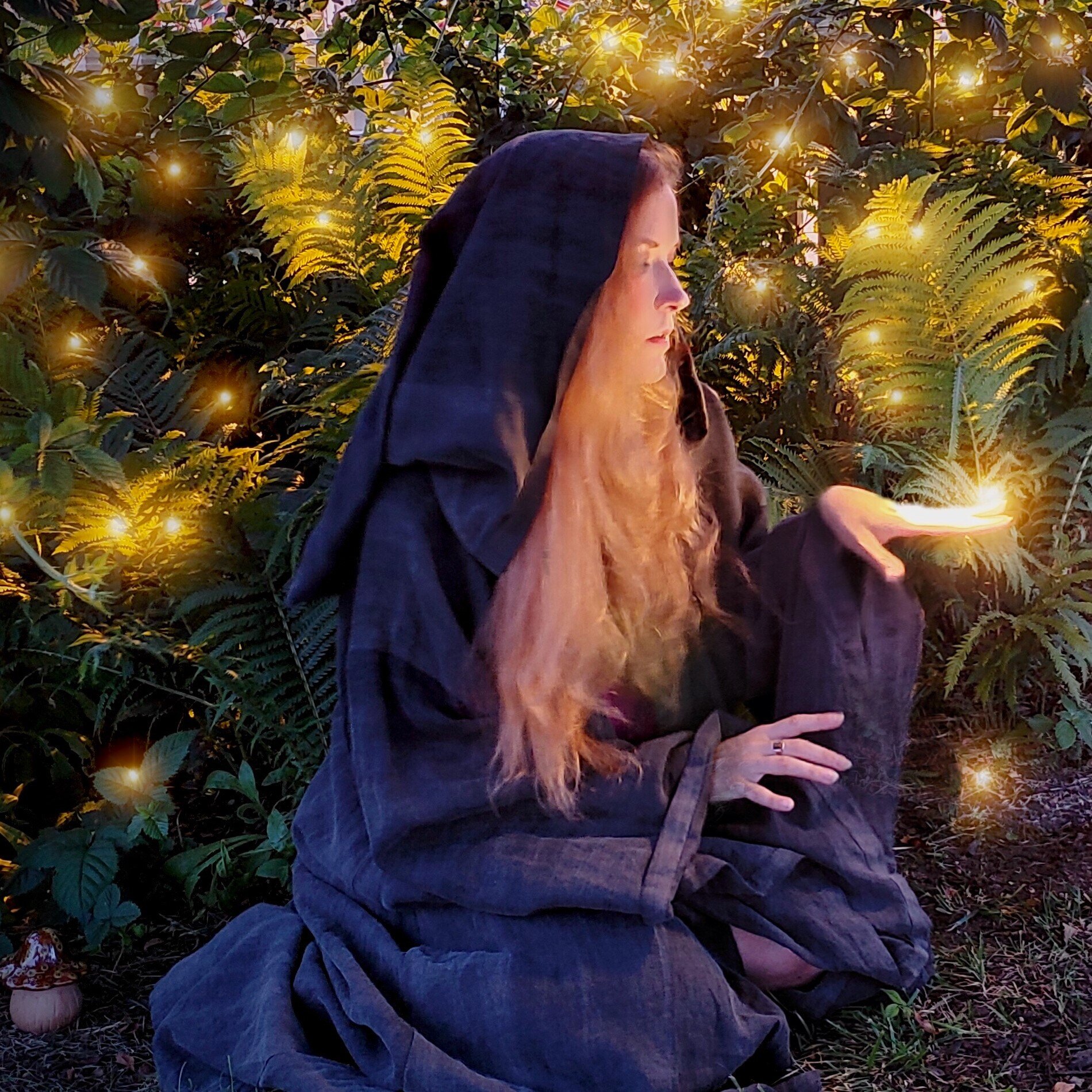Firefly Summers - Magic, Folklore, and Memory
/I was sixteen years old, and he was my first love. We were traveling on a packed bus together through the mountains of Tennessee, headed back to our convention hotel after exploring Rock City and Lookout Mountain. He had just asked me to be his girlfriend an hour earlier, through a note, of course, and he hesitantly reached for my hand as we sat side by side on the sticky plastic seat of the un-air-conditioned bus. The air sizzled with electricity between us, and nothing else existed in the world..
Until he dropped my hand and pressed his face to the glass of the window, gasping loudly. “Are those fireflies??” he exclaimed, eyes shining with glee.
Confused, I looked out at the fields as they swept by. “…Yes?”
It’s not that I didn’t realize fireflies were magical, it was just that they were such a part of my Ohio childhood I never even fathomed until that moment that there might be people who had never seen one. Jesse, who would go on to be my first boyfriend (long distance), lived in Oregon, and indeed had never in his entire life seen a single field of fireflies flashing in the humid warmth of a summer night.
Image by Garth Battista
I remember a childhood full of fireflies, or lightning bugs, as they are called pretty much just as often in Ohio. I recall catching one carefully in a cupped hand and watching the edges of my fingers glow as the tickle of its little feet whispered across the skin of my palm. I remember moving to the country when I was fourteen, and the open fields all around our hundred-year-old house lighting up with a Morse code of flashing lights every twilight. When the air was so thick with summer heat that you could smell the green of growing things all around you, the fireflies would appear, quietly hovering on silent wings.
So just what are these mysterious insects of the night? First, they aren’t actually insects, really, but beetles of the lampyrid family. The males fly in a “J” formation, dipping down close to the earth to flash their light, and then soaring upward to see if any females respond to their mating signal. The flashes are not only a flirtation, but also are a warning to any would-be predators. The luciferin that makes fireflies glow also tastes noxious to most animals who would snack on them, who have learned over time that a glowing bum equals a nasty dinner.
And speaking of that remarkable light, it is the single most efficient light source in the world, with almost a hundred percent of the energy in the chemical reaction between luciferin and luciferase emitted as light. Luciferin also has several medical uses thus far discovered (and likely many more undiscovered), including testing for microbial contamination in foods, helping to quickly determine effective cancer cell drugs, and aiding in non-invasive imaging inside living organisms. Synthetic versions of luciferin now exist, thankfully offering an alternative to extracting the compound from the beetle itself.
Image by Garth Battista
Fireflies can be found on every continent except Antarctica, and firefly folklore and superstitions vary widely. The Victorians believed that a firefly in the house meant that someone was going to die. In the Mediterranean, firefly light rises from graves and is also considered a danger. The Ewe people of Togo and Ghana tell stories of a legendary vampiric being known as adze. The adze can take the form of a firefly, but it can also possess humans. As a firefly, it can pass through solid doors to come into a person’s home and drink their blood. (Adze)
The ghosts of Japanese warriors sometimes return as fireflies, but are revered and respected. The warriors hailed from two warring clans, and for a long time, their battle was reenacted once a year on the Uji River, when all captured fireflies were released in one night to wage war. (Insect Facts and Folklore)
A sweet Japanese children’s folk song mentions the glowing beetle:
Firefly, come hither, and you shall
have water to drink! Yonder the
water is bitter—here the water is
sweet! Come, fly this way, to the
sweet side!
(Elizabeth May, “Japanese Children’s Folk Songs before and after Contact with the West”)
A Hopi animal story tells of a firefly who came across a Navajo man who was preparing to use his sweat lodge. Firefly asked to join him in sweating all the dirt from his body. The man agreed, and the building grew hotter and hotter, until the firefly’s shell burst open, killing the man. The beetle himself, however, had a shell within his shell, and walked away safely, singing a song. The moral of the tale was to never kill a firefly. (Hopi Animal Stories)
Fox helped the Apache people to obtain fire by stealing it from the fireflies and lighting his own tail on fire with a piece of burning wood. He then ran from the fireflies with help from cedar tree, hawk, and crane. The firefly villagers punished him by telling Fox that he would never be able to use fire himself. (The Origin of Fire)
And in a Japanese fairy tale, Hotaru-Himé, princess of the fireflies, refused to marry unless her suitor could accomplish an impossible task and bring her fire. One by one, her potential suitors failed the test, succumbing to candle or lamp, until Hi-Mar, the prince of fireflies, came and filled her palace with his own golden glow, winning her love. (The Firefly Princess)
Although those of us in the United States may know this beetle by the name firefly or lightning bug, they are also known as glow flies, moon bugs, golden sparklers, fire devils, hotaru (Japan), peeni-walli (Jamaica), jugnu (Urdu), and luciérnaga (Spanish). Even more names can be found here.
Image by Garth Battista
My heart always fills with joy when I see my very first firefly each summer, such a “blink and you miss it” moment where I ask myself if I really saw that glowing ember flash of light or if it was my imagination. Then, over the next few days, more lights join in at twilight. But in the last few years, I’ve noticed that what was once a twinkling spectacle at dusk each day has turned into a small handful of glitter here and there. The fireflies are disappearing.
After I saw this beautiful video posted by artist Scott Radke a week ago, I started thinking about fireflies again, about my memories of holding one in my hands as a child, and the idea of this blog post formed. The night of July fifth, I went for a solo drive at twilight, as my husband was settling into sleep, to see if I could find a field of fireflies. I thought, even though my suburban neighborhood with my neighbor’s bright motion sensor light and streetlamps was seeing fewer and fewer firefly flashes, surely I could find a meadow nearby where the lightning bugs still gleamed.
It was a relaxing drive through the darkness of the nearby farm country, driving down side roads I knew well and suspected might have potential for flickering lights in the dark. The sky turned gold above me, and then dull grey as the sun set and full darkness fell. I drove past a park with a forest trail where I walk often, and saw the gate hadn’t been locked.
Image by Garth Battista
Pulling into the gravel lot, I turned off my headlights and waited. And…I saw the same thing I had seen in my own city neighborhood: a few meager twinkling lights, like lonely islands in the darkness. My heart sank. Where were the farmland fields full of fire from my childhood? Where had the fireflies gone?
The answer, of course, is that we are to blame: fireflies are dwindling thanks to habitat loss, light pollution, and pesticides (firefly larvae can stay underground for up to two years, and lawn fertilizers and treatments are increasingly popular).
I backed my car back onto the road, wincing at the crackle of the gravel in the quiet. As I drove the rest of the way home, heart breaking in that distinct way of seeing something beautiful disappearing from the world, I noticed how few areas of full darkness I passed along the road. The fireflies had nowhere to hide, nowhere to go.
Image by Garth Battista
After parking my car back in the garage, I sat on my bench at the bottom of the garden, disappointed, to put it mildly. Light filled half my backyard, and the other half lay in the shadow of my beloved hawthorn tree. I winced as I heard the loud pop pop crack of fireworks as they exploded in garish colors from a house nearby. I shook my head at the irony: people creating their own chemical and powder flash and dazzle. How many missed the fireflies or even noticed they were gone?
I squinted at the lawn in the tree’s silhouette, and saw a single blinking golden light in the darkness. Walking over to where I last saw the flash, I bent down and stared, a foot away from where I could see his tiny beetle body crawling up and down various blades of grass. For a moment I was tempted to hold him in my cupped hands and watch the glow from between my fingers, just like I did as a child. But now, he was too precious to risk holding, risk damaging. I stayed bent over in the grass for a while, watching him blink against the dark every minute or so.
It was a vigil. A moment of mindfulness. Magic passes from this world sometimes, and darkness exists in so many places as well as light. Sometimes there is so little we can do about the biggest sources of darkness and despair. But we can still do what we can. We have to. We can live gently on this earth. Shine our light, feeble as it may sometimes be. And we can sit for a while with the fireflies, what few remain.











